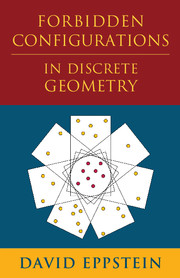Book contents
- Frontmatter
- Contents
- Acknowledgments
- 1 A Happy Ending
- 2 Overview
- 3 Configurations
- 4 Subconfigurations
- 5 Properties, Parameters, and Obstacles
- 6 Computing with Configurations
- 7 Complexity Theory
- 8 Collinearity
- 9 General Position
- 10 General-Position Partitions
- 11 Convexity
- 12 More on Convexity
- 13 Integer Realizations
- 14 The Stretched Geometry of Permutations
- 15 Configurations from Graphs
- 16 Universality
- 17 Stabbing
- 18 The Big Picture
- Bibliography
- Index
7 - Complexity Theory
Published online by Cambridge University Press: 04 May 2018
- Frontmatter
- Contents
- Acknowledgments
- 1 A Happy Ending
- 2 Overview
- 3 Configurations
- 4 Subconfigurations
- 5 Properties, Parameters, and Obstacles
- 6 Computing with Configurations
- 7 Complexity Theory
- 8 Collinearity
- 9 General Position
- 10 General-Position Partitions
- 11 Convexity
- 12 More on Convexity
- 13 Integer Realizations
- 14 The Stretched Geometry of Permutations
- 15 Configurations from Graphs
- 16 Universality
- 17 Stabbing
- 18 The Big Picture
- Bibliography
- Index
Summary
When we find ourselves unable to come up with an efficient algorithm for a computational problem, it is often possible to find an explanation (if not a rigorous proof that the algorithm does not exist) using the techniques of computational complexity theory.
Decision Problems and Complexity Classes
A computational problem can be described by a mathematical specification of its input and of the desired output for each input. This specification does not describe how to compute the output efficiently; that is the task of the algorithm designer. Within complexity theory, a special place is taken by the decision problems, the problems whose output is always either yes or no. A complexity class is a set of decision problems, usually grouped by how much time or memory their algorithms require.
In this theory, three of the most important complexity classes are P, NP, and the class of NP-complete problems.We describe them briefly here; for an accessible and more in-depth treatment, see Fortnow (2013).
• P is the class of problems with yes-or-no answers that can be solved by an algorithm whose runtime is polynomial in the number of bits of input. For example, one can test whether a list of points (given by Cartesian coordinates as binary numbers) contains any repeated points, by comparing each pair of points and checking whether they are equal. This algorithm takes time proportional to the square of its input length, a polynomial. It is also possible to solve the same problemmore quickly, using sorting or hashing.
• NP is a larger class of yes-or-no problems, not all of which are believed to have efficient algorithms.However, whenever the answer to a problem in NP is “yes,” there must exist a short and easily checked proof that the answer is yes.Many common puzzles, such as sudoku, can be formulated as problems in NP.1 For such puzzles, the yes-or-no question is “does this puzzle have a solution?” or “if I add this step tomy answer, will it still have a solution?” The proof that it does have a solution is the solution itself. Although the solution may be hard to find, it is easy to check that it is valid.
Information
- Type
- Chapter
- Information
- Forbidden Configurations in Discrete Geometry , pp. 43 - 52Publisher: Cambridge University PressPrint publication year: 2018
